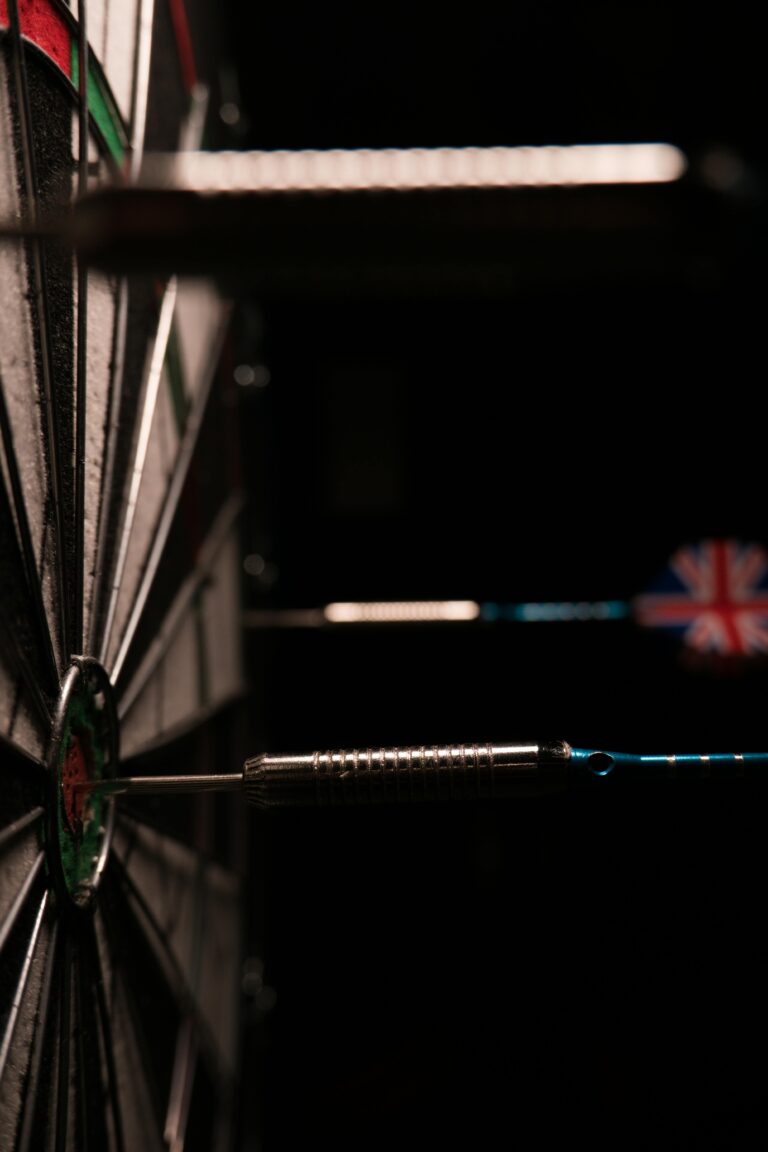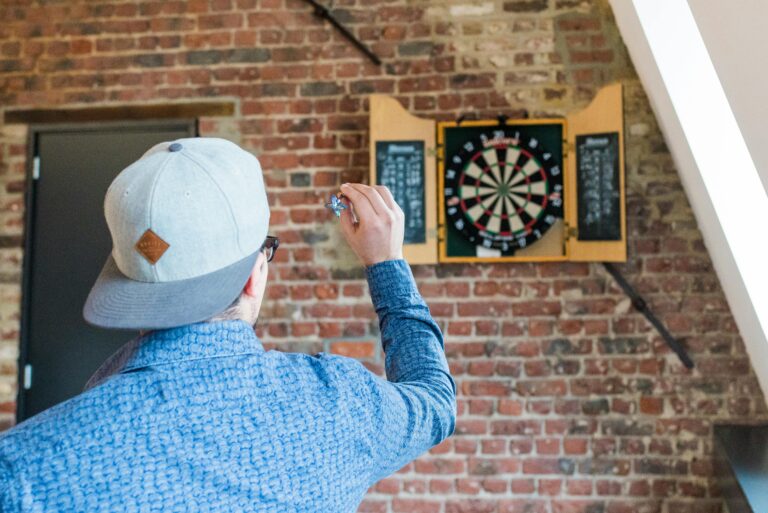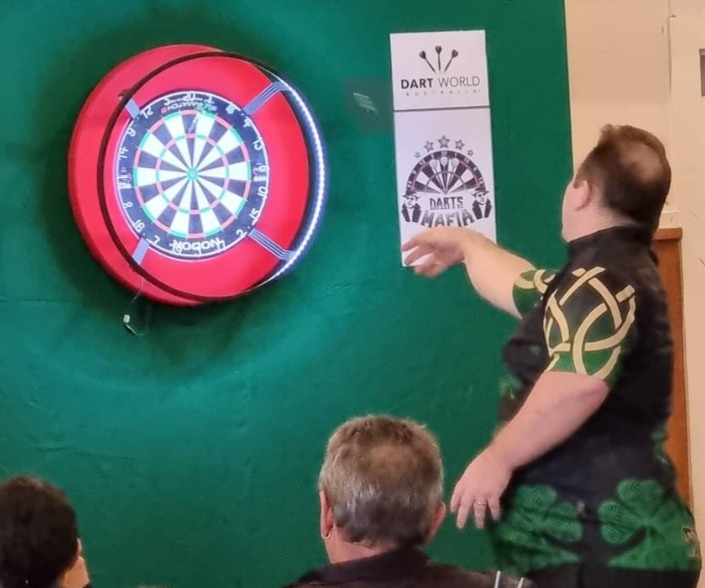7 Best Facts About Darts Game History
When you think about darts, you might picture a casual pub game, but its history is far more intricate and enthralling. Did you know that it all started with mediaeval soldiers throwing arrows at wine barrels for fun? This simple pastime evolved into a structured game that faced legal battles to be recognised as a sport of skill. From the dartboards’ transformation to the role of pubs in fostering a lively community, each fact reveals a unique chapter in the game’s history. Curious about how darts leapt from local pubs to global competitions? There’s much more to uncover.
Mediaeval Origins
Darts originated in the UK during the Middle Ages as a pastime for soldiers, who likely threw arrows at upturned wine barrels to pass the time. This rudimentary activity not only provided entertainment but also served as a form of skill practice, akin to archery.
The shift from arrows to darts was a natural progression as soldiers sought a more manageable and less cumbersome alternative to traditional archery targets. By using wine barrels, they could create a makeshift target that was easily accessible and portable.
Over time, these upturned wine barrels evolved into more structured targets, mimicking the concentric circles found on archery targets. The simplicity of this setup allowed soldiers to engage in friendly competition, honing their precision and aim.
This gradual evolution laid the groundwork for the modern dartboard, with its distinct scoring areas and bullseye. The game’s accessibility and minimal equipment requirements made it popular among soldiers and civilians alike, ensuring its widespread adoption.
Early Game Illegality
In the early 20th century, legal battles raged over whether darts was a game of skill or simply a game of chance. Darts faced significant court challenges, with authorities frequently classifying it as gambling. However, the turning point occurred in 1908, during a landmark case involving William ‘Bigfoot’ Anakin in Leeds.
To address the legal ambiguity, Jim Garside, a pub owner, orchestrated a legal demonstration to prove that darts required skill. Garside invited Anakin to showcase his dart-throwing expertise in court. Anakin’s performance wasn’t merely a spectacle but a calculated effort to illustrate the game’s complexity. Under scrutiny, Anakin consistently hit high-scoring areas of the dartboard, thereby demonstrating a level of precision that couldn’t be attributed to mere luck.
This display was pivotal in persuading the court that skill was a significant factor in darts. As a result, the court ruled in favour of darts, officially declaring it a game of skill rather than chance. This decision not only legalised darts but also paved the way for its widespread acceptance and growth.
The ruling underscored the importance of skill in the game, liberating it from the constraints of gambling laws.
Evolution of Dartboards
While legal recognition solidified darts as a game of skill, the development of dartboards played a critical role in shaping the modern game. Darts’ early enthusiasts likely used sections of tree trunks as makeshift targets, capitalising on the natural rings to guide their throws. This rudimentary setup laid the groundwork for more sophisticated designs.
In the late 19th century, Brian Gamlin’s introduction of a standardised point system revolutionised the game. His layout, which strategically alternates high and low scoring areas, guarantees a fair and challenging experience for players. The arrangement minimises the effect of luck, emphasising skill and precision.
Over time, dartboard materials evolved from solid wood to more durable options. Initially, boards were made from elm wood, but the shift to century plant fibres and later to sisal fibres improved longevity and playability. These materials absorb dart impacts better, making the game more enjoyable and consistent.
The construction and mathematical considerations of modern dartboards reflect a deep understanding of gameplay dynamics. Whether made from sisal fibres, cork, or coiled paper, each material offers a unique playing experience, ensuring that the evolution of dartboards continues to enrich the game of darts.
Military Influence
The origins of darts can be traced back to the 1300s, when English soldiers used it as a pastime to maintain morale and prevent desertion. Picture soldiers in their camps, engaging in this simple yet entertaining activity. They’d throw sharp projectiles at upturned wine casks or sections of tree trunks, creating an early form of the dartboard we understand today. This activity wasn’t just for fun; it helped keep the soldiers focused and sharp, both mentally and physically.
By turning to these recreational soldiers, you can see how military influence shaped the game. Darts evolved from these humble beginnings, showing how even in times of conflict, leisure activities had significant roles. Throwing sharp projectiles allowed soldiers to practice precision, a skill that was certainly beneficial in combat scenarios.
Here’s a quick breakdown of the military’s influence on darts:
| Aspect | Military Influence | Impact on Darts |
|---|---|---|
| Origin | Recreational soldiers | Early dartboards |
| Equipment | Sharp projectiles | Darts development |
| Purpose | Morale and focus | Strategic precision |
| Evolution | From military to recreational | Accessibility and spread |
These factors underscore how darts evolved from a military pastime to a beloved game, highlighting its enduring appeal and simplicity.
Pub Popularity
Essentially, darts found its way into pubs in the early 1900s, transforming these establishments into vibrant hubs for social interaction and competition. Pubs became the epicentres of pub culture, where people gathered not just for a drink but to engage in community bonding through friendly competition.
The simplicity and accessibility of darts made it an attractive pastime for pub-goers of all backgrounds. You’d find that the game’s rules were easy to grasp, which encouraged widespread participation. This inclusivity fostered a sense of socialisation that transcended age and class, making the game a unifier in a diverse social setting. Pub patrons quickly discovered that darts offered an enjoyable yet competitive way to spend their leisure time.
The organisation of leagues and tournaments within pubs further cemented darts’ role in community bonding. These events transformed casual players into competitive enthusiasts, enhancing the pub experience. The competitive spirit, combined with the camaraderie fostered in these settings, contributed to the game’s enduring popularity.
Essentially, pubs weren’t just serving drinks; they were cultivating a community where darts played a pivotal role in social interaction and friendly competition.
Modern Regulations
As darts evolved from a popular pub pastime to a competitive sport, regulatory bodies began to formalise the game’s rules and standards to guarantee fair play and consistency. The National Darts Association first set out these rules in 1925, which the British Darts Organisation later adopted in the 1970s. This formalisation was pivotal as it ensured that no matter where you played, the game remained consistent.
Player etiquette became an essential part of these regulations. You’re expected to show respect to your opponent and avoid any behaviour that could distract them during their throw. This respect for the game and fellow players is foundational to modern darts.
The World Darts Federation (WDF) has been instrumental in setting the standards for playing dimensions, scoring rules, and equipment specifications. They’ve ensured that scoring techniques are consistent, whether you’re playing at home or in a professional tournament.
The split in governance in 1992, resulting in the creation of the Professional Darts Corporation (PDC), further refined these standards to promote fair competition.
Thanks to these regulations and the sport’s growing commercial appeal, darts has transformed from a casual game into a respected, globally recognised sport.
Global Competitions
Why have global competitions become the pinnacle of the darts world, drawing elite players and massive audiences alike? They bring together the best talents, showcasing skill and precision on an international stage. Events like the World Darts Championship, which has been held annually since 1978, are prime examples. The Professional Darts Corporation (PDC) and the British Darts Organisation (BDO) host prestigious tournaments, such as the World Matchplay and the BDO World Darts Championship, respectively. These events spotlight player rivalries that captivate fans and fuel intense competition.
Global competition has thrived due to international expansion. They attract top players from various countries, expanding the sport’s reach and influence. This diverse participation enriches the competition, introducing different styles and strategies. Substantial prise money is another key factor, with winners earning significant financial rewards. This not only motivates players but also enhances the sport’s appeal to a broader audience.
Frequently Asked Questions
What Are Some Interesting Facts About Darts?
You’ll find darts fascinating, with famous players like Phil Taylor. Some unusual rules include breaking when you exceed the required score. Understanding these nuances can deepen your appreciation and skill in this strategic game.
What Is the History of the Game Darts?
Darts’ history traces back to its military origins in the Middle Ages, evolving through pub culture. Soldiers threw arrows at wine barrels, evolving into tree trunk targets, standardising dartboards, and eventually forming leagues and championships.
How Old Is the Sport of Darts?
You’d think modern sports are old, but darts origins trace back to a mediaeval pastime from 1300s England. It’s a 700-year-old game that began with soldiers throwing sharp objects for fun. Now, it’s a global phenomenon.
Why Are Darts Played From 501?
You play darts from 501 because it creates a balanced scoring methodology. This format demands precision and strategic game strategies, making each throw vital. It guarantees an exciting, competitive edge while maintaining achievable goals for all players.
Conclusion
Coincidentally, the journey of darts mirrors society’s evolution—from mediaeval soldiers’ pastimes to a globally recognised sport.
You see, it’s not just a game; it’s a historical tapestry woven with military precision, pub camaraderie, and legal victories.
As you explore deeper, you realise darts encapsulate a broader narrative of skill triumphing over chance.
This rich history, marked by strategic advancements and community spirit, underscores why darts aren’t merely entertainment but a tribute to human ingenuity and perseverance.







